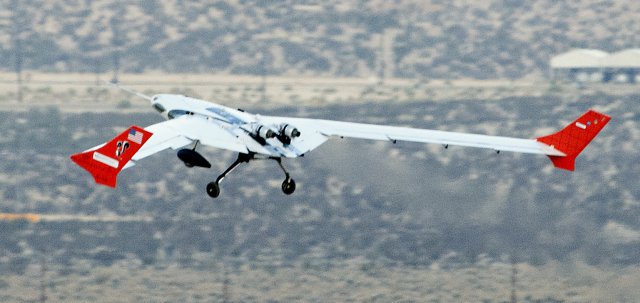 The US Air Force Research Laboratory, in conjunction with Lockheed Martin and NASA, recently took a major step in the development of active aircraft control technologies with the first flight on July 26 of the X-56A Multi-Utility Technology Testbed flight demonstrator, at NASA Dryden Flight Research Center at Edwards AFB, California.
The US Air Force Research Laboratory, in conjunction with Lockheed Martin and NASA, recently took a major step in the development of active aircraft control technologies with the first flight on July 26 of the X-56A Multi-Utility Technology Testbed flight demonstrator, at NASA Dryden Flight Research Center at Edwards AFB, California.
The X-56A is an innovative, modular, unmanned flight research vehicle that will allow investigation of active aeroelastic control technologies such as active flutter suppression and gust load alleviation. Flutter is a potentially catastrophic instability that can occur when unsteady aerodynamic forces acting on an aircraft structure couple with its natural vibration modes. This is the same basic phenomenon that caused the 1940 collapse of the Tacoma Narrows Bridge. The X-56A is designed to exhibit multiple rigid body and aeroelastic instabilities within its flight envelope, which will be actively managed by its flight control system.
During this first flight, the X-56A flew at low altitude for 14 minutes while crews evaluated the aircraft’s handling qualities at 70 knots and collected airspeed calibration data using GPS methods. Handling qualities were also evaluated at 60 knots upon landing approach. The flight was completed successfully, with the aircraft behaving as predicted.
The X-56A demonstrator is designed to allow the testing of a wide range of advanced aerodynamic concepts and technologies. It is powered by twin JetCat P400 turbojets, has a 28-foot wing span, weighs 480 pounds, and is designed and constructed for easy wing replacement. The research to be conducted with the X-56A is critical for the successful development of future slender, lightweight, high-aspect-ratio wing designs that could be used by energy-efficient transport and various unmanned aircraft.
Following Air Force flight testing, the X-56A will be used by the Fixed Wing Project of NASA’s Fundamental Aeronautics Program for their continuing research into lightweight structures and advanced technologies for future low-emissions transport aircraft.
Photo: NASA photo by Kenneth E. Ulbrich
Source: Wright-Patterson Air Force Base
